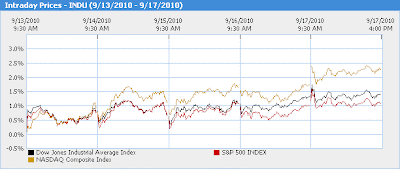A solid showing on Friday pushed the markets to their fourth straight weekly gain. At the close, the Dow rose 2.4%, the S&P 500 gained 2.1%, and the Nasdaq was higher by 2.8%. Oil climbed 2.1% and gold continued on its tear, up 1.6% to another record high.
Source: MSN Moneycentral
There was a lot going on this week that we would like to get to. Starting from the very beginning, Monday morning, it was announced that the
Tuesday marked the announcement from the Federal Reserve on the interest rate and their take on the strength of the economy. It was no surprise that they are keeping interest rates at a record low, but they also indicated that they see no inflation in the near future. That info, along with a statement that they are "prepared to provide additional accommodation if needed to support the economic recovery" gave us good insight into future Fed actions. It signaled that they were set to provide further quantitative easing, which, in their view, is intended to stimulate the economy.
A major effect from this quantitative easing will be a weaker dollar, and therefore higher commodity prices. You can already see it happening, as the dollar has been selling off, while commodity prices are rising.
This week marked another record high for gold, as it crossed the $1,300 level at one point. Other metals like silver, platinum, and copper are at or near new highs, as well. But this phenomenon isn’t limited to just the metals.
 In the chart on the right provided by the Wall Street Journal, you can see how the price of cotton is at new highs. We are also seeing new highs in wheat, corn, sugar, coffee, and beef, just to name a few. While supply issues have contributed to the rise, the impact of a weak dollar cannot be overlooked.
In the chart on the right provided by the Wall Street Journal, you can see how the price of cotton is at new highs. We are also seeing new highs in wheat, corn, sugar, coffee, and beef, just to name a few. While supply issues have contributed to the rise, the impact of a weak dollar cannot be overlooked.
This goes back to what we were talking about last week - things you buy will cost more (inflation), while things you own are worth less (deflation). We believe this is a terrible scenario for the
Finally we get to Friday and the strong market rise. Lackluster reports on housing and durable goods orders were released in the morning, so we don’t see that as the contributing factor. We believe an appearance by a prominent hedge fund manager (David Tepper of Appaloosa Management) on CNBC helped send the markets higher. It was before the bell, and you can see the impact it had on the Friday open in the chart above.
He believes that the support coming from the Fed will provide a backdrop to send the markets higher. Part of the quantitative easing will be to purchase securities so stock prices will rise. Basically, the Fed will try their hardest to not let stock prices fall (similar to what they are doing with housing prices). It may not be good in the long run, but might as well take advantage of what the Fed is doing and make some money off it.
Next Week
A bit lighter next week in terms of economic releases, and we will be watching data on consumer confidence and personal income and spending.
Of particular note, the US House Chamber will possibly be voting on a bill next week to add tariffs to Chinese imports. It is believed that they have artificially kept the value of their currency low to make their exports to us more appealing (although we are trying to do the same thing). The announcement will likely mark the beginnings of a trade war with
Where are we investing now?
We somewhat agree with David Tepper (as mentioned above) and believe the Fed will do everything in its power to send the stock market higher. We would wait for a pullback first, as we believe there is still plenty of bad news coming before the Fed steps in (although they have quietly been rather active up to this point).
The likely weaker dollar provides opportunities to invest in commodities, although we would also wait for a pullback before venturing into this area. Gold and precious metals have been an exciting story this year and we are pleased with the results.
We still see poor economic conditions hampering the economy, though, so we remain cautious. The potential higher taxes, increasing government involvement in the private sector, and a still-high unemployment rate is a negative for the longer term, no matter how much Fed tries to send prices higher.
In equities, we are focused on higher-quality and multi-national stocks, but some smaller stocks look promising, as well. A weak dollar would be a plus for export-oriented companies. We continue to avoid banking and insurance sector stocks. TIPs are important as we expect inflation to increase in the future, while
Commodities remain a longer term favorite, as mentioned above, as inflation will also impact prices to the upside. Municipal bonds will play a more important role in our portfolios over the coming months and years as higher tax rates take effect. Finally, we are optimistic about international stocks, as emerging markets (excluding




